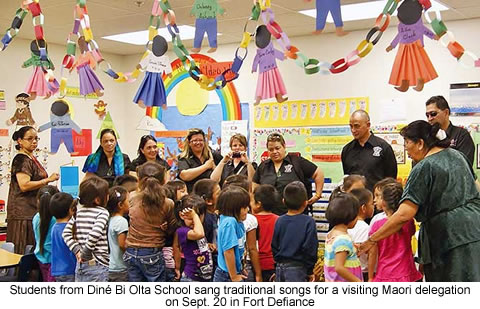 |
Canku Ota
|
 |
|
(Many Paths)
|
||
|
An Online Newsletter
Celebrating Native America
|
||
|
November
1, 2011 - Volume 9 Number 11
|
||
|
|
||
|
Maori Come to
Learn Language Preservation
|
||
|
by Erny Zah - Navajo
Times
|
||
|
"We're here to listen and learn from the Navajo Nation," said Hemi Rau, an educational leader and advocate for Maori language immersion schools in New Zealand. The group of eight Maoris spent the day touring the Window Rock area and listening to officials from the Department of Diné Education, the vice president's office and other tribal agencies discuss Navajo efforts to preserve the language. Rau said his group was interested in learning how indigenous people in the United States preserve or, in many cases, revive their native languages. The Navajo Nation was one stop in a two-week tour of the country that included New York City and two Keres-speaking pueblos, Acoma and Cochiti. As the group toured the only public Navajo language immersion school on the reservation, Rau and his group talked about the struggles the Maori people have had in preserving their language and culture against waves of European immigrants. New Zealand is now part of the British Commonwealth, its governing systems modeled on those of the English, and many of the Maori's experiences mirror the fight for recognition of indigenous rights by the U.S. government. "We have had the same struggles," said Kalvin White, educational administrator with the Office of Diné Science, Math and Technology. Rau said Maori leaders too concluded that language preservation would help instill pride in their traditions, which would in turn create well-being for individual tribal members because they would have a better sense of their cultural identity. "Ideally, it would be good for Maori children to attend tribal schools," Rau said. White agreed. In earlier interviews, White and other DODE officials have said learning Navajo culture would help Navajo individuals prosper because they would have a secure sense of their identity. However, one large advantage exists for the Maoris that doesn't exist in the U.S. - backing by federal and state authorities for a curriculum decided entirely by the Maoris themselves. Rau said New Zealand recognizes Maori schools as "special character" schools, and allows the Maori people to dictate the education their students receive without significant interference from New Zealand education officials. |
|
|
||
|
|
||
| Canku Ota is a free Newsletter celebrating Native America, its traditions and accomplishments . We do not provide subscriber or visitor names to anyone. Some articles presented in Canku Ota may contain copyright material. We have received appropriate permissions for republishing any articles. Material appearing here is distributed without profit or monetary gain to those who have expressed an interest. This is in accordance with Title 17 U.S.C. Section 107. | ||
|
Canku Ota is a copyright ©
2000, 2001, 2002, 2003, 2004, 2005, 2006, 2007, 2008, 2009, 2010,
2011 of Vicki Barry and Paul Barry.
|
||
 |
 |
|
|
The "Canku
Ota - A Newsletter Celebrating Native America" web site and
its design is the
|
||
|
Copyright ©
1999, 2000, 2001, 2002, 2003, 2004, 2005,
2006, 2007, 2008, 2009, 2010, 2011
of Paul C. Barry.
|
||
|
All Rights Reserved.
|
||
 Eleven
students greeted a group of New Zealand educators with a traditional
Navajo song as they walked into Diné Bi Olta School Sept.
20.
Eleven
students greeted a group of New Zealand educators with a traditional
Navajo song as they walked into Diné Bi Olta School Sept.
20.